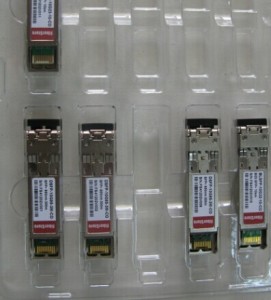IAs data centers and enterprises strive to future proof their infrastructures while maximizing their current networks, the flexibility of true dual rate compliant interfaces eases the transition to higher Gigabit Ethernet systems. This is why the dual rate optical transceiver has emerged. And today, I’d like to talk something about the dual rate optical transceiver, especially the dual rate SFP+.

What Is Dual Rate SFP+ Optical Transceiver?
As its name suggests, dual rate optical transceiver is a kind of optical transceiver which can support two different data rates. With the dual rate optical transceiver, users can achieve the full forward and backward compatibility of their systems with a low cost. The common dual rate optical transceivers in the today’s market is the 1G/10G dual rate SFP+ transceiver. They are compatible with either 10 Gigabit Ethernet or 1 Gigabit Ethernet fiber interface. There are many different vendors to supply the 1G/10G dual rate SFP+, but the standards and protocols which they complied with are the same. In general, the 1G/10G dual rate SFP+ are designed for use in 1 Gigabit and 10 Gigabit Ethernet links over single-mode or multi-mode fiber. They are compliant with SFF-8431, IEEE 802.3-2005 10GBASE-SR/SW, 10GBASE-LR and 1000BASE-SX, 1000BASE-LX. In addition, similar to most modern optical transceivers, digital diagnostics monitoring (DDM) or digital optical monitoring (DOM) functions are also available in the dual rate SFP+, so that users can monitor many parameters of the transceiver module in real-time. Actually, with the development of technology and the increasing demands on higher Gigabit Ethernet, there are other dual rate optical transceivers with different package styles or even at different data rates except the 1G/10G dual rate SFP+, eg. Multi-rate XFP or dual rate XFP.
Why Dual Rate SFP+ Is Needed?
In my opinions, the emergence of dual rate optical transceiver is mostly because of the cost consideration. From 1G to 10G, 10G to 40G, 40G to 100G, and even higher data rate, it means that the development of Gigabit Ethernet is very fast. In other words, the cost of updating the equipment keeps adding up over time. dual rate optical transceiver is a cost-effective solution to solve this question. For example, a 1G/10G dual rate SFP+ can be used in both 1 Gigabit Ethernet and 10 Gigabit Ethernet links which eases the transition from 1Gb/s to 10Gb/s systems. Users can configure to operate the dual rate optical transceivers at 1GbE or 10GbE in a switch with 10G SFP+ ports and 1G/10GSFP+ ports, but not native 1G SFP ports. And do not have to spend extra cost in buying optical transceivers only support 1G or 10G Ethernet. Of course, if you only need one type of Gigabit Ethernet, you do not need to use the dual rate optical transceiver. So, at this time, the more cost-effective choice is to buy a corresponding single-rate optical transceiver. Nowadays, 10G Ethernet is the most commonly used type of Ethernet as the 40G and 100G are still developing. Thus, the market of 1G/10G dual rate SFP+ is not so popular as its first emergence. But it is still applied in 1000BASE-SX 1G Ethernet, 1000BASE-LX 1G Ethernet, 10GBASE-SR/SW 10G Ethernet and 10GBASE-LR 10G Ethernet as a cost-effective solution for 1G/10G Ethernet.
Dual Rate SFP+ Transceiver Recommendation
From this paper, you may have an understanding of the dual rate SFP+ optical transceiver. There are many verdors offer dual rate fiber transceivers, Fiberstore is one of them. Fiberstore high-quality and low price dual rate 1G/10G SFP+ or cheap 10G dual xfp which can be designed to be compatible with many major brands, such as Cisco, HP, Juniper etc. Buy 10G dual XFP or SFP+, welcome to send E-mail to sales@fs.com.
Related Article:
SFP Module: What’s It and How to Choose It?



